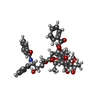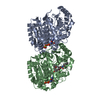[English] 日本語
 Yorodumi
Yorodumi- PDB-1jff: Refined structure of alpha-beta tubulin from zinc-induced sheets ... -
+ Open data
Open data
- Basic information
Basic information
| Entry | Database: PDB / ID: 1jff | ||||||
|---|---|---|---|---|---|---|---|
| Title | Refined structure of alpha-beta tubulin from zinc-induced sheets stabilized with taxol | ||||||
 Components Components |
| ||||||
 Keywords Keywords |  STRUCTURAL PROTEIN / dimer / STRUCTURAL PROTEIN / dimer /  GTPase GTPase | ||||||
| Function / homology |  Function and homology information Function and homology informationpositive regulation of axon guidance / cytoplasmic microtubule / microtubule-based process / cellular response to interleukin-4 /  Hydrolases; Acting on acid anhydrides; Acting on GTP to facilitate cellular and subcellular movement / structural constituent of cytoskeleton / microtubule cytoskeleton organization / microtubule cytoskeleton / Hydrolases; Acting on acid anhydrides; Acting on GTP to facilitate cellular and subcellular movement / structural constituent of cytoskeleton / microtubule cytoskeleton organization / microtubule cytoskeleton /  double-stranded RNA binding / mitotic cell cycle ...positive regulation of axon guidance / cytoplasmic microtubule / microtubule-based process / cellular response to interleukin-4 / double-stranded RNA binding / mitotic cell cycle ...positive regulation of axon guidance / cytoplasmic microtubule / microtubule-based process / cellular response to interleukin-4 /  Hydrolases; Acting on acid anhydrides; Acting on GTP to facilitate cellular and subcellular movement / structural constituent of cytoskeleton / microtubule cytoskeleton organization / microtubule cytoskeleton / Hydrolases; Acting on acid anhydrides; Acting on GTP to facilitate cellular and subcellular movement / structural constituent of cytoskeleton / microtubule cytoskeleton organization / microtubule cytoskeleton /  double-stranded RNA binding / mitotic cell cycle / double-stranded RNA binding / mitotic cell cycle /  nervous system development / nervous system development /  microtubule / protein heterodimerization activity / microtubule / protein heterodimerization activity /  GTPase activity / GTPase activity /  ubiquitin protein ligase binding / GTP binding / ubiquitin protein ligase binding / GTP binding /  metal ion binding / metal ion binding /  cytosol / cytosol /  cytoplasm cytoplasmSimilarity search - Function | ||||||
| Biological species |   Bos taurus (cattle) Bos taurus (cattle) | ||||||
| Method |  ELECTRON CRYSTALLOGRAPHY / ELECTRON CRYSTALLOGRAPHY /  electron crystallography / electron crystallography /  MOLECULAR REPLACEMENT / MOLECULAR REPLACEMENT /  cryo EM / Resolution: 3.5 Å cryo EM / Resolution: 3.5 Å | ||||||
 Authors Authors | Lowe, J. / Li, H. / Downing, K.H. / Nogales, E. | ||||||
 Citation Citation |  Journal: J Mol Biol / Year: 2001 Journal: J Mol Biol / Year: 2001Title: Refined structure of alpha beta-tubulin at 3.5 A resolution. Authors: J Löwe / H Li / K H Downing / E Nogales /  Abstract: We present a refined model of the alpha beta-tubulin dimer to 3.5 A resolution. An improved experimental density for the zinc-induced tubulin sheets was obtained by adding 114 electron diffraction ...We present a refined model of the alpha beta-tubulin dimer to 3.5 A resolution. An improved experimental density for the zinc-induced tubulin sheets was obtained by adding 114 electron diffraction patterns at 40-60 degrees tilt and increasing the completeness of structure factor amplitudes to 84.7 %. The refined structure was obtained using maximum-likelihood including phase information from experimental images, and simulated annealing Cartesian refinement to an R-factor of 23.2 and free R-factor of 29.7. The current model includes residues alpha:2-34, alpha:61-439, beta:2-437, one molecule of GTP, one of GDP, and one of taxol, as well as one magnesium ion at the non-exchangeable nucleotide site, and one putative zinc ion near the M-loop in the alpha-tubulin subunit. The acidic C-terminal tails could not be traced accurately, neither could the N-terminal loop including residues 35-60 in the alpha-subunit. There are no major changes in the overall fold of tubulin with respect to the previous structure, testifying to the quality of the initial experimental phases. The overall geometry of the model is, however, greatly improved, and the position of side-chains, especially those of exposed polar/charged groups, is much better defined. Three short protein sequence frame shifts were detected with respect to the non-refined structure. In light of the new model we discuss details of the tubulin structure such as nucleotide and taxol binding sites, lateral contacts in zinc-sheets, and the significance of the location of highly conserved residues. #1:  Journal: Nature / Year: 1998 Journal: Nature / Year: 1998Title: Structure of the alpha beta tubulin dimer by electron crystallography Authors: Nogales, E. / Wolf, S.G. / Downing, K.H. | ||||||
| History |
|
- Structure visualization
Structure visualization
| Movie |
 Movie viewer Movie viewer |
|---|---|
| Structure viewer | Molecule:  Molmil Molmil Jmol/JSmol Jmol/JSmol |
- Downloads & links
Downloads & links
- Download
Download
| PDBx/mmCIF format |  1jff.cif.gz 1jff.cif.gz | 184.9 KB | Display |  PDBx/mmCIF format PDBx/mmCIF format |
|---|---|---|---|---|
| PDB format |  pdb1jff.ent.gz pdb1jff.ent.gz | 139.9 KB | Display |  PDB format PDB format |
| PDBx/mmJSON format |  1jff.json.gz 1jff.json.gz | Tree view |  PDBx/mmJSON format PDBx/mmJSON format | |
| Others |  Other downloads Other downloads |
-Validation report
| Arichive directory |  https://data.pdbj.org/pub/pdb/validation_reports/jf/1jff https://data.pdbj.org/pub/pdb/validation_reports/jf/1jff ftp://data.pdbj.org/pub/pdb/validation_reports/jf/1jff ftp://data.pdbj.org/pub/pdb/validation_reports/jf/1jff | HTTPS FTP |
|---|
-Related structure data
| Related structure data |  1tubS S: Starting model for refinement |
|---|---|
| Similar structure data |
- Links
Links
- Assembly
Assembly
| Deposited unit | 
| ||||||||
|---|---|---|---|---|---|---|---|---|---|
| 1 |
| ||||||||
| Unit cell |
|
- Components
Components
-Protein , 2 types, 2 molecules AB
| #1: Protein | Mass: 50107.238 Da / Num. of mol.: 1 / Source method: isolated from a natural source / Source: (natural)   Bos taurus (cattle) / Organ: Brain Bos taurus (cattle) / Organ: Brain / References: UniProt: P81947*PLUS / References: UniProt: P81947*PLUS |
|---|---|
| #2: Protein | Mass: 49907.770 Da / Num. of mol.: 1 / Source method: isolated from a natural source / Source: (natural)   Bos taurus (cattle) / Organ: Brain Bos taurus (cattle) / Organ: Brain / References: UniProt: Q6B856*PLUS / References: UniProt: Q6B856*PLUS |
-Non-polymers , 5 types, 5 molecules 








| #3: Chemical | ChemComp-ZN / |
|---|---|
| #4: Chemical | ChemComp-MG / |
| #5: Chemical | ChemComp-GTP /  Guanosine triphosphate Guanosine triphosphate |
| #6: Chemical | ChemComp-GDP /  Guanosine diphosphate Guanosine diphosphate |
| #7: Chemical | ChemComp-TA1 /  Paclitaxel Paclitaxel |
-Details
| Sequence details | THE SAMPLE WAS BOVINE, BUT THE MODELED PROTEIN SEQUENCES ARE FROM SUS SCROFA (PIG). THE AUTHORS ...THE SAMPLE WAS BOVINE, BUT THE MODELED PROTEIN SEQUENCES ARE FROM SUS SCROFA (PIG). THE AUTHORS USED THE SEQUENCES FROM THE MOST ABUNDANT ISOTYPE OF PIG BRAIN TUBULIN. THE RESIDUES IN CHAIN B ARE NOT SEQUENTIAL |
|---|
-Experimental details
-Experiment
| Experiment | Method:  ELECTRON CRYSTALLOGRAPHY / Number of used crystals: 200 ELECTRON CRYSTALLOGRAPHY / Number of used crystals: 200 |
|---|---|
| EM experiment | Aggregation state: 2D ARRAY / 3D reconstruction method:  electron crystallography electron crystallography |
- Sample preparation
Sample preparation
| Component | Name: Alpha-Beta-tubulin sheets / Type: COMPLEX |
|---|---|
| Specimen | Embedding applied: YES / Shadowing applied: NO / Staining applied : NO / Vitrification applied : NO / Vitrification applied : YES : YES |
| EM embedding | Material: tannin |
Vitrification | Cryogen name: NITROGEN |
| Crystal | Description: JEOL 4000 electron microscope was used. Kodak film and gatan CCD were used as detectors. Temperature was 93 Kelvin. |
Crystal grow | Temperature: 305 K / Method: aberrant polymerization of tubulin / pH: 5.8 Details: Zn++, pH 5.8, aberrant polymerization of tubulin, temperature 305K |
| Crystal grow | *PLUS Method: unknown |
-Data collection
| EM imaging |
| |||||||||||||||
|---|---|---|---|---|---|---|---|---|---|---|---|---|---|---|---|---|
| Image recording | Film or detector model: GENERIC FILM / Details: low dose | |||||||||||||||
| Diffraction |
| |||||||||||||||
| Diffraction source | Source: ELECTRON MICROSCOPE / Type: JEOL 4000 electron microscope / Wavelength: 0.0194 Å | |||||||||||||||
| Detector |
| |||||||||||||||
| Radiation | Protocol: SINGLE WAVELENGTH / Monochromatic (M) / Laue (L): M / Scattering type: electron | |||||||||||||||
| Radiation wavelength | Wavelength : 0.0194 Å / Relative weight: 1 : 0.0194 Å / Relative weight: 1 | |||||||||||||||
| Reflection | Resolution: 3.5→20 Å / Num. all: 12422 / Num. obs: 12422 / % possible obs: 73 % / Observed criterion σ(F): 0 / Observed criterion σ(I): 0 / Redundancy: 6 % / Biso Wilson estimate: 40 Å2 / Rmerge(I) obs: 0.25 / Net I/σ(I): 5.4 | |||||||||||||||
| Reflection shell | Resolution: 3.5→3.7 Å / Mean I/σ(I) obs: 2.3 / Num. unique all: 1080 / % possible all: 73 | |||||||||||||||
| Reflection | *PLUS % possible obs: 73 % |
- Processing
Processing
| Software |
| ||||||||||||||||||||
|---|---|---|---|---|---|---|---|---|---|---|---|---|---|---|---|---|---|---|---|---|---|
| Refinement | Method to determine structure : :  MOLECULAR REPLACEMENT MOLECULAR REPLACEMENTStarting model: PDB entry 1TUB Resolution: 3.5→20 Å / Isotropic thermal model: overall anisotropic / σ(F): 0 / σ(I): 0 / Stereochemistry target values: Engh and Huber / Details: constrained
| ||||||||||||||||||||
| Displacement parameters | Biso mean: 41.4 Å2
| ||||||||||||||||||||
| Refinement step | Cycle: LAST / Resolution: 3.5→20 Å
| ||||||||||||||||||||
| Refine LS restraints |
| ||||||||||||||||||||
| LS refinement shell | Resolution: 3.5→3.66 Å
| ||||||||||||||||||||
| Software | *PLUS Name: CNS / Version: 0.9 / Classification: refinement | ||||||||||||||||||||
| Refinement | *PLUS Highest resolution: 3.5 Å / Lowest resolution: 20 Å / σ(F): 0 / Rfactor obs: 0.231 | ||||||||||||||||||||
| Solvent computation | *PLUS | ||||||||||||||||||||
| Displacement parameters | *PLUS Biso mean: 41.4 Å2 | ||||||||||||||||||||
| LS refinement shell | *PLUS Highest resolution: 3.5 Å |
 Movie
Movie Controller
Controller
























 PDBj
PDBj







